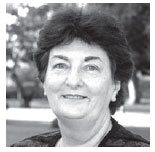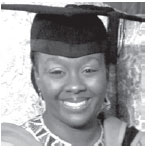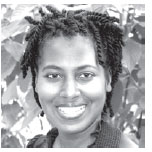Our new doctors
Coming from the 19 PhD students featured here who graduated during the 2013 ceremonies, is a fascinating range of subject areas for their research. Their abstracts suggest that the thesis material must be riveting and that their contribution to human understanding and development is significant. The body of work included fibre reinforced composites; what the television life can do; diabetes protection; mathematical models of crime, spiders; choosing health programmes; youth and HIV; mediation and restorative justice, and trade barriers.
Faculty of Engineering
RICHARD A. BACHOO
The High Frequency Vibration of Fibre Reinforced Composites
Fibre reinforced composites (FRCs) form an important class of materials that are used extensively in applications that exploit their high strength to weight and modulus to weight ratios. Statistical energy analysis (SEA) is the most common tool used for the high frequency vibration problems of complex structures. One critical parameter required by SEA is the modal density.
In this study analytic expressions, independent of boundary conditions, are derived for the modal density of thin and thick FRC beams cross coupled in bending and torsion. The variation of the modal density with fibre orientation is investigated, showing that there exists in every frequency band an orientation that corresponds to a minimum modal density. The variation of the modal energy levels across the modal spectrum is also investigated.
 Faculty of Humanities and Engineering Faculty of Humanities and Engineering
KAREN ECCLES
Trinidadian Women and World War 2
This thesis examines the contributions of Trinidadian women to World War 2. The lopsided version of their experience, the Jean and Dinahs, painted mostly by calypsonians and male observers at the time and perpetuated to this day, is by no means the whole truth. It looks again at this derogatory reputation and reveals the violence, abuse, murders, rapes and sexual slavery which also occurred.
It also examines the role middle and upper class women played in the war and the organizations they formed, including the Auxiliary Territorial Services, the female branch of the British army. Other women formed groups, organizations and guilds, and worked from clubs, borrowed halls and their homes. With the support of hundreds of women they engaged in raising funds, in food security, in assisting wounded soldiers and in organizing for their entertainments.
 Faculty of Humanities and Engineering Faculty of Humanities and Engineering
MARSHA PEARCE
Caribbean Ventilation: Experiencing Television as Window in the Anglophone Islands
The dissertation is a qualitative study of the phenomenon of screen media reception in an Anglophone Caribbean context, with the aim of illustrating how television and audience operate in Caribbean culture. Specifically, it looks at audience engagement with TEMPO, a cable television channel launched in 2005 for a primary target market of Caribbean people. The research argues that in the reception of TEMPO, an Anglophone Caribbean audience engages with the television as a virtual window that facilitates a complex, multidimensional experience of what I call “Caribbean ventilation” – ventilation, in one sense, referring to a scrutiny and interrogation of notions of “Caribbean” (ventilating what Caribbean means) and in another sense, as a flow between a represented, on-screen Caribbean and a lived Caribbean.
 Faculty of Humanities and Engineering Faculty of Humanities and Engineering
ROBERTHA EVANS
An Examination of the Language Use Patterns and Practices of the Legal System in St Lucia
This thesis focused on human rights; it addressed the right to freedom from discrimination. Linguistic discrimination is a pervasive global issue, particularly in post-colonial jurisdictions, which accord de jure or de facto standing to one language in the legal system. This is usually an ex-colonial language that is often not the primary language of the majority of the persons it serves. The language gap between this language and the language competence of some persons could have far-reaching implications for issues of justice. The study examined the use of English as the sole official language of the legal system in St Lucia, looking at how the system operates to provide access to justice for people of various language backgrounds, especially Kwéyòl-dominant speakers.
 Institute for Gender and Development Studies Institute for Gender and Development Studies
CATHERINE ALI
Navigating Empowerment in Mediation and Restorative Justice in Trinidad
This study researches transformation in mediation and restorative justice. It focuses on gang crime conflicts in two masculinities transformation projects: Bail Boys Court at San Fernando Supreme Court and Men’s Forum: School for Tabanca in Point Fortin. Structures, interactions, identities and kinship boundaries shifted as empowered change agents facilitated discovery.
Men who said they were “not made human” discovered how to fill human development gaps in their sons’ lives. Character and gender identities expanded, and former gang members “turned their lives around” with positive implications for women and children.
Findings include new cultural mediation models for youth justice and restorative justice that transform crimogenic masculinities and structures. Methodologies for anchoring the fluidities of empowerment and transformation demonstrate the importance of situated gender research for human security, and for social and criminal justice policy development locally and globally.

 Faculty of Medical Sciences Faculty of Medical Sciences
ARLENE WILLIAMS
The role of Leonotis nepetifolia as a hepatoprotective agent against acetaminophen-induced toxicity in vivo
This study utilised an orally administered acetaminophen-induced mouse model of hepatocellular damage to determine the hepatic effect of Leonotis nepetifolia leaf extracts. Pre- and post-treatments of the methanol and aqueous extracts were carried out and a comparison done to measure the level of protection observed in blood and liver tissue with matched histopathology. The novel hepatoprotective properties of Leonotis nepetifolia leaf extracts showed a significant reduction in serum ALT and AST levels in both pre- and post- treated mice and an overall reduction in liver enzyme activity compared to the acetaminophen-induced control group. Matched histological sections showed hepatoprotection with maintained hepatocellular architecture. We were able to quantify and observe architectural as well as biochemical changes in the liver with pre- and post- treatments.
 Faculty of Medical Sciences Faculty of Medical Sciences
DEBBIE HILAIRE
Burden of Chronic Non-Communicable Disease and Lifestyle Behavior among University Staff: Effect of a Lifestyle Intervention
Staggering increases in health insurance claims by University staff suggested a significantly high burden of disease, with NCDs and their risk factors suspected as major culprits. The overall aim therefore was to assess disease burden, identify associated risk factors and formulate a culturally appropriate intervention. A cross-sectional study was conducted on 273 randomly selected University staff. Standardized measurements of anthropometry, dietary intake, biochemistry and lifestyle were made. Intervention included standardized protocols for promoting healthy eating, increased physical activity, close monitoring and monthly workshops that resulted in mean decreases in weight, BMI and waist circumference for females. The significant improvements in anthropometric and certain NCD risk factors highlight the value of culturally appropriate intensive lifestyle interventions in reducing disease burden.
 Faculty of Medical Sciences Faculty of Medical Sciences
SHAMJEET SINGH
Cardiac gene and protein expression in sucrose-fed rodent models of insulin resistance: preventive effect of anthocyanins
Type 2 diabetes mellitus (DM) contributes to several illnesses, including heart diseases, stroke, cataracts and kidney failure. It is characterized by high levels of glucose (sugar) in the blood and is normally preceded by a “pre-diabetic” stage, our research utilized rodent models and sought to understand changes that may occur in cardiac cells during pre-diabetes—a period when reversal of defects is theoretically possible. We identified specific genes and proteins in the heart, liver and muscle tissues that are altered during this period. These were associated with changes in the expression of contractile proteins, which suggest contractile inefficiencies. This can aid techniques to detect diabetes, intervention strategies and drug development for heart disease, and work in nutrient-gene interaction and systems biology.
 Faculty of Social Sciences Faculty of Social Sciences
HENRY BAILEY
A Framework for the Prioritization of Health Programmes for Trinidad and Tobago
This study seeks to identify a suitable framework to optimize healthcare resource allocation decision-making for Trinidad and Tobago. Based on a review of the local context, theoretical issues, and international experience, Programme Budgeting and Marginal Analysis (PBMA) using Cost Utility Analysis applying the EQ-5D descriptive system is presented as an ideal initial framework for T&T. A new visual analogue scale (VAS) protocol and two discrete choice experiment (DCE) designs are developed and tested. The VAS and the D-Efficient DCE are found to perform as well as methods used in other countries involving much larger respondent samples and requiring highly trained interviewers. An EQ-5D Value set is developed for T&T using the DCE data. An implementation agenda for T&T is also presented.
 Faculty of Social Sciences Faculty of Social Sciences
TRACIE ROGERS
In the Silence of their Skin: Negotiating HIV Disclosure and Young Adulthood in Trinidad and Tobago
This thesis was a participatory action research study that partnered with youth to investigate HIV as a psychosocial reality. Research on HIV risk and youth have characteristically treated young people as two mutually exclusive sub-populations, namely HIV negative and HIV positive. This dichotomy ignores the reality that these sub-populations are part of each other’s social world. Data was generated through in-depth interviews, photography and youth-led data analysis with cohorts of HIV positive and negative young people. Youth participants were involved in every aspect, from design through data analysis and dissemination of findings. Two original contributions to the literature resulted: a youth-in-environment theoretical perspective for understanding the impact of HIV on psychosocial wellbeing of youth and a responsive social work practice model with a focus on HIV disclosure within an ecological framework.
 Faculty of Social Sciences Faculty of Social Sciences
CHUKWUDI DAVID ANYANWU
The impact of technical barriers to trade on small and medium enterprises in Trinidad and Tobago
This research focused on the impact of technical barriers to trade on small and medium enterprises (SMEs) in Trinidad and Tobago and the process of improving their trade-related capacity to meet product standards and regulations in export markets. The thesis argued that the impact of technical barriers applied as standards and regulations on food and beverage exporting SMEs in developing countries is more damning because in many respects they lack the necessary trade-related capacity to meet the various product-related requirements in export markets; a prerequisite for international competitiveness. This study provides a useful framework for the development of a Trade-Related Capacity Building Approach (TRCBA) in standards towards international competitiveness for SMEs in the food and beverage industry in Trinidad and Tobago.

 Faculty of Science & Technology Faculty of Science & Technology
CURTIS BOODOO
The motion of complex biological fluid in the human body
We developed a mathematical model for blood flow in arteries and capillaries. A Non-Newtonian fluid was used to model blood flow and the glycocalyx layer within capillaries was modeled as a porous region. We also modelled peristaltic transport in the large intestine. The successive contraction of a Peristaltic wave was modelled using a sinusoidal waveform. This waveform travelled along a porous tube containing biological fluid. Then we modelled oral drug delivery using porous microspheres. In oral drug delivery specific drugs are embedded within the porous region of the microspheres and when consumed these drugs slowly assimilate within the body. We found that optimal drug delivery occurs with a porous sphere of low permeability and the optimal microsphere shape is a whole porous sphere and not a porous shell.
 Faculty of Science & Technology Faculty of Science & Technology
JO-ANNE NINA SEWLAL
Contribution of Habitat Diversity to the Biodiversity of the Spider Families Araneidae, Nephilidae and Tetragnathidae in Trinidad, WI
The biodiversity of three orb-weaving spider families, Araneidae, Nephilidae and Tetragnathidae were compared among thirteen natural habitats and three habitats that experienced increasing degrees of human disturbance; secondary forest, cocoa fields, and farmland, respectively. Both vegetation structure and plant species composition influenced spider biodiversity, especially abundance and species-richness in natural habitats, with four habitats (savannah, mangrove woodland, littoral woodland and herbaceous swamp) possessing distinct species assemblages. The increasing amount of secondary and agricultural vegetation as a result of land-clearing raises the question of how disturbance affects biodiversity. Overall, disturbed habitats were not significantly different from natural habitats in terms of biodiversity. Conserving biodiversity in the tropics is more than protecting rainforests; all habitat types need to be protected to preserve spider biodiversity.
 Faculty of Science & Technology Faculty of Science & Technology
JOANNA SOOKNANAN
Mathematical Models of Crime
Gang-related crime is becoming an increasing problem in Trinidad and Tobago. Modelling offers a means of testing the suggested solutions by varying conditions so as to conduct social experiments; but without the ethical concerns and costs attached to experimenting on humans. In this research, mathematics and numerical simulation form a dynamic duo in the modelling process and crime-fighting initiative. The growth of gangs, the infiltration of gangs into the police service and the switching of territory by marauding criminal gangs with their capture by police were studied using models adapted from Mathematical Biology. The dynamic behaviour of these systems was investigated with stability and bifurcation analyses. The models are useful in exploring the effect of different crime prevention strategies and may be used to identify thresholds that determine the establishment or disappearance of criminals.
 Faculty of Science & Technology Faculty of Science & Technology
Lorale Jeanine Lalgee
Synthetic Ion Transporters: Membrane Activity of Amphiphilic Cobalt-Cage Complexes with Aza Crown Spacer
Membrane transport underlies the research into the molecular basis of diseases such as cancer, epilepsy and cystic fibrosis. The function and mechanism of transmembrane ion channels is extensively studied in modern biological chemistry and validates a growing thrust to investigate synthetic systems capable of regulating ion flow across biological membranes. These model systems contribute to understanding the behavior of naturally occurring ion channels, and have numerous practical applications in fields such as drug delivery and nanomedicine, and biosensor development. We investigated the ion transport potential and biological activity of a homologous series of cobalt-cage metallosurfactants. We characterized the molecular interactions between these novel metallosurfactants and a range of (phospholipid) membrane mimetic systems; to gain insight into their suprastructural membrane activity and mechanisms of action.
 Faculty of Science & Technology Faculty of Science & Technology
MARISSA MOSES
Genetic Variability of Capsicum chinense
I investigated the genetic variability of the small but charismatic vegetable, Capsicum chinense, commonly known to West Indians as hot pepper. This species is indigenous to northern South America and the Caribbean, which provides a unique genetic reservoir for building better pepper varieties. Hot peppers are known throughout the world for their attractive glossy berries, distinctive flavour profiles, record-breaking levels of pungency, and resistance to diseases. These superior physical attributes are a direct result of the high levels of genetic variability in the Caribbean cluster or gene pool that I determined using molecular (DNA) fingerprinting techniques.
As part of the research team at The UWI, I am pleased to contribute to the continuing efforts of local researchers, in developing a profitable hot pepper industry in the Caribbean and a global seed industry.
 Faculty of Science & Technology Faculty of Science & Technology
NIGEL JOHN
The Development and Optimization of a novel UWI/BP/Strata Polymer Cracking Reactor to study Depolymerisation of Polystyrenes
My research involved modifying/redesigning a reactor (with others) to produce a working reactor: the UWI/BP/Strata polymer cracking rig. The advantage of this rig is in its greater cracking flexibility: a wider variety of products can be obtained by varying independently process parameters; temperature, stirring rates, residence times and cracking in the semi-batch and continuous flow sections of the reactor. The modified rig was used to study the depolymerisation of polystyrenes. The secondary products are useful solvents and can with scale-up of the plant produce potentially economically viable alternative energy/fuel sources from waste polystyrene (Styrofoam), that is “energy on tap from waste plastics” in addition to the obvious “green alternative” to environmentally unfriendly usual solid waste management of waste (plastic) polystyrene.
 Faculty of Science & Technology Faculty of Science & Technology
SIMONE F.A. WALCOTT
Phytochemical Investigation of Croton species from Trinidad
Croton species from the Euphorbiaceae family are best known for the tiglianediterpenes which are tumor promoting. More recently, various other diterpene types have been isolated from Croton. The latex of C. gossypifolius along with the leaves and stems of local Croton species, Croton gossypifoliusand C. hircinus, were investigated for their secondary metabolites. A novel cyclic nonapeptide, Crotogossamide, was isolated from the latex of C. gossypifoliusalong with the flavonoids, quercitrin, myricitrin and afzelin and the amino acid derivative tyramine.
Brine-shrimp bioassay-guided fractionation of the crude extract of the leaves of Croton gossypifolius led to the isolation of the known vomifoliol, dehydrovomifoliol and hypoleucolide methyl ester, as well as pinoresinol and kaempferol as minor components. Three novel clerodanediterpenes, Crotohircin A-C were isolated from the leaves of C. hircinus along with the flavonoids artemetin and kaempferol.
 Faculty of Science & Technology Faculty of Science & Technology
RACHEL WYSE-MASON
Biodiesel from Used Cooking Oil: Evaluation of Production Methods and Engine Emissions
The impact of vehicular emissions on climate change has boosted global research into alternative fuels such as biodiesel. This renewable diesel fuel can be produced from any lipid, with vegetable oils being the most common feedstock. It generates more than 50% less emissions than petroleum diesel, improves the condition of the engine and can be used without any major engine modification. In this study, the conversion of waste cooking oil into biodiesel was investigated for different types of restaurants in Trinidad and Tobago. The best feedstock and production methods were then identified considering four properties; waste oil characteristics, conversion into biodiesel, biodiesel fuel properties and emissions characteristics.

|




 Faculty of Humanities and Engineering
Faculty of Humanities and Engineering Faculty of Humanities and Engineering
Faculty of Humanities and Engineering Faculty of Humanities and Engineering
Faculty of Humanities and Engineering Institute for Gender and Development Studies
Institute for Gender and Development Studies

 Faculty of Medical Sciences
Faculty of Medical Sciences Faculty of Medical Sciences
Faculty of Medical Sciences Faculty of Medical Sciences
Faculty of Medical Sciences Faculty of Social Sciences
Faculty of Social Sciences Faculty of Social Sciences
Faculty of Social Sciences Faculty of Social Sciences
Faculty of Social Sciences
 Faculty of Science & Technology
Faculty of Science & Technology Faculty of Science & Technology
Faculty of Science & Technology Faculty of Science & Technology
Faculty of Science & Technology Faculty of Science & Technology
Faculty of Science & Technology Faculty of Science & Technology
Faculty of Science & Technology Faculty of Science & Technology
Faculty of Science & Technology Faculty of Science & Technology
Faculty of Science & Technology Faculty of Science & Technology
Faculty of Science & Technology